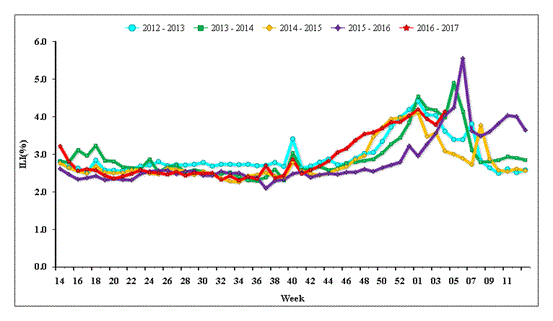Weekly Report
Week 04 2017
Article source: Date time:2017-02-22
Download:Download:China flu report 1704.pdf
Chinese Influenza Weekly Report
(All data are preliminary and may change as more reports are received)
|
Summary l During week 4, influenza activity is at intra-seasonal levels both in southern and northern China with A(H3N2) virus epidemic, but it showed a trend of downward recently. l Among influenza viruses antigenically characterized by CNIC since September, 2016, 50(100%) influenza A(H1N1)pdm09 viruses were characterized as A/California/7/2009-like; 181(61.1%) influenza A(H3N2) viruses were characterized as A/Hong Kong/4801/2014 (H3N2)(EGG)-like,287(97%) influenza A(H3N2) viruses were characterized as A/Hong Kong/4801/2014 (H3N2)(CELL)-like; 151(100%) influenza B/Victoria viruses were characterized as B/Brisbane/60/2008-like; 51(92.7%) influenza B/Yamagata viruses were characterized as B/Phuket/3073/2013-like. l Among the influenza viruses tested by CNIC for antiviral resistance analysis since September, 2016, all influenza A(H1N1)pdm09 and all influenza A(H3N2) viruses were resistant to adamantine; All influenza A(H1N1)pdm09 and all influenza H3N2 and B viruses were sensitive to neuraminidase inhibitors. |
Outbreak Surveillance
During week 4 (Jan 23th- 29th, 2017), there were no outbreak reported nationwide.
Surveillance of outpatient or emergency visits for Influenza-like Illness (ILI)
During week 4, the percentage of outpatient or emergency visits for ILI (ILI %) at national sentinel hospitals in south China was 3.3% , higher than last week, the same week of 2015 and 2016(2.8%、3.2% and 3.1%). (Figure 1)

Figure 1. Percentage of Visits for ILI at Sentinel Hospitals in South China
(2012-2017)
During week 4, ILI% at national sentinel hospitals in north China was 4.1%, higher than last week, the same week of 2015 and 2016(3.8%、3.1% and 4.0%). (Figure 2)

Figure 2. Percentage of Visits for ILI at Sentinel Hospitals in North China
(2012-2017)
Virologic Surveillance
During week 4, influenza network laboratories tested 6468 specimens, of which 1078(16.7%) were positive for influenza, influenza A and influenza B virus were 1045(96.9%) and 33(3.1%), respectively (Table 1). During week 4, the percentage of specimens that were tested positive for influenza in south China was 12.3%, which was lower than the previous week (13.4%) (Figure 3).During week 2, the percentage of specimens that were tested positive for influenza in north China was 21.4%, which was lower than the previous week (23.1%)(Figure 4).
Table 1 Laboratory Detections of ILI Specimens (Week 4, 2017)
|
|
Week 2 |
||
|
South China |
North China |
Total |
|
|
No. of specimens tested |
3376 |
3092 |
6468 |
|
No. of positive specimens (%) |
415(12.3%) |
663(21.4%) |
1078(16.7%) |
|
Influenza A |
394(94.9%) |
651(98.2%) |
1045(96.9%) |
|
A(H3N2) |
364(92.4%) |
498(76.5%) |
862(82.5%) |
|
A(H1N1)pdm09 |
23(5.8%) |
152(23.3%) |
175(16.7%) |
|
A (subtype not determined) |
7(1.8%) |
1(0.2%) |
8(0.8%) |
|
Influenza B |
21(5.1%) |
12(1.8%) |
33(3.1%) |
|
B (lineage not determined) |
0(0%) |
0(0%) |
0(0%) |
|
Victoria |
15(71.4%) |
12(100%) |
27(81.8%) |
|
Yamagata |
6(28.6%) |
0(0%) |
6(18.2%) |

Figure 3. Influenza Positive Tests Reported by Southern Network Laboratories (Week 14, 2015–Week 4, 2017)
Note: Analysis in this part was based on the test results of network laboratories. If it were not consistent with the results of CNIC confirmation, the results of CNIC confirmation were used.

Figure 4. Influenza Positive Tests Reported by Northern Network Laboratories (Week 14, 2015–Week 4, 2017)
Note: Analysis in this part was based on the result of network laboratories. If it were not consistent with the results of CNIC confirmation, the results of CNIC confirmation were used.
Antigenic Characterization
Since September 1st, 2016, all of the 50 A(H1N1)pdm09 viruses tested were characterized as A/California/7/2009-like;181(61.1%) of the 296 A(H3N2) influenza viruses tested were characterized as A/Hong Kong/4801/2014 (H3N2)(EGG)-like, 287(97%) of the 296 A(H3N2) influenza viruses tested were characterized as A/Hong Kong/4801/2014 (H3N2)(CELL)-like; all of the 151 influenza B/Victoria lineage viruses tested were characterized as B/Brisbane/60/2008-like; 51(92.7%) of the 55 influenza B/Yamagata lineage viruses tested were characterized as B/Phuket/3073/2013-like.
Antiviral Resistance
Since September 1st, 2016, among the influenza viruses tested by CNIC for antiviral resistance, all influenza A(H1N1)pdm09 and all influenza A(H3N2) viruses were resistant to adamantine ; All influenza A(H1N1)pdm09 and all influenza A(H3N2) and B viruses were sensitive to neuraminidase inhibitors.

